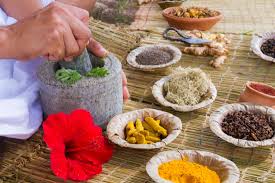Living with psoriatic arthritis (PsA) means managing both joint pain and skin challenges. While conventional treatments are vital, a range of herbal and natural remedies can support you along the way. Always chat with your healthcare provider before trying anything new, especially if you’re on medications or treatments.
1. Turmeric (Curcumin)
This vibrant spice isn’t just flavorful—it’s packed with curcumin, a potent anti-inflammatory compound. Research suggests it may ease joint pain and stiffness in PsA by blocking inflammatory cytokines HealthlineMedical News Today. A 2016 review found benefits at about 1,000 mg/day of curcumin, though high doses can interact with blood thinners or cause stomach upset Healthline.
2. Fish Oil (Omega-3 Fatty Acids)
Omega-3s from fish oil help dial down inflammation and can improve both skin and joint symptoms in PsA. A 2018 study noted fish oil supplementation reduced joint tenderness and stiffness HealthlineMedical News TodayAcibadem Healthpoint.
3. Ginger
Similar to turmeric, ginger contains powerful anti-inflammatory compounds. While PsA-specific studies are limited, ginger has been shown to alleviate inflammation in rheumatoid and osteoarthritis HealthlineAcibadem Healthpoint.
4. Capsaicin (Topical)
Found in chili peppers, capsaicin creams and ointments can “dull” pain signals and help reduce joint discomfort and skin symptoms like scaling or redness Medical News TodayWebMDRheumatoidArthritis.org.
5. Aloe Vera
Applying a 0.5% aloe cream up to three times daily may soothe the redness and scaling of psoriasis—not directly easing joint pain, but calming the skin symptoms common in PsA Baba-MailHealthline.
6. Willow Bark
Nature’s own “aspirin,” willow bark contains salicin and has been studied for pain relief in osteoarthritis. Though not yet tested specifically for PsA, it’s often used as a herbal pain reliever—but be cautious of interactions with other medications Psoriatic-Arthritis.comRheumatoidArthritis.org.
7. Oregon Grape (Mahonia aquifolium)
Creams with 10% Oregon grape have shown effectiveness in relieving mild-to-moderate psoriasis symptoms, which can indirectly help PsA sufferers by reducing skin flares WebMDHealthline.
8. Epsom Salts & Dead Sea Salts
A warm soak (92–100°F) in Epsom or Dead Sea salts may relieve joint pain, inflammation, and itchy skin. Minerals and temperature both play soothing roles for a peaceful at-home spa moment Medical News TodayHealthline.
9. Chinese Herbal Medicine (e.g., Wogonin)
Emerging research from 2024 reveals that certain Chinese herbal formulations particularly those containing wogonin may target immune inflammation in PsA by modulating cytokine pathways like IL-17, TNF-α via PI3K/AKT signaling PubMed.
10. Black Cumin Seed Oil (Nigella sativa)
A brand-new randomized controlled trial suggests that black cumin seed oil may ease arthritis pain and morning stiffness, thanks to its anti-inflammatory and antioxidant properties. While not PsA-specific yet, it’s showing promise for arthritis in general The Economic TimesThe Times of India.
Lifestyle & Complementary Supports
Beyond herbs, complementary therapies and lifestyle choices can help manage PsA holistically:
- Diet & Gut Health: Following an anti-inflammatory diet rich in whole foods and omega-3s can help manage flares. Emerging research links gut bacteria with PsA development, making gut health a key area of interest Verywell HealthCourier Mail.
- Stress-Reduction & Movement: Gentle yoga, tai chi, meditation, and mindful breathing can reduce both stress and pain sensitivity. Many patients find stress is a key flare trigger Medical News TodayAcibadem HealthpointVerywell HealthSELF.
- Topicals & Baths: Oatmeal baths, essential oils (like lavender or rosemary), and moisturizers free of fragrances can calm skin irritation from psoriasis WebMDHealthline.
Wrapping It Up
Herbal remedies such as turmeric, fish oil, ginger, capsaicin, aloe vera, willow bark, Oregon grape, and emerging options like wogonin and black cumin offer complementary strategies to soothe both skin and joint symptoms of PsA. While these treatments can provide remarkable relief for some, they’re best used alongside not in place of standard medical care.
